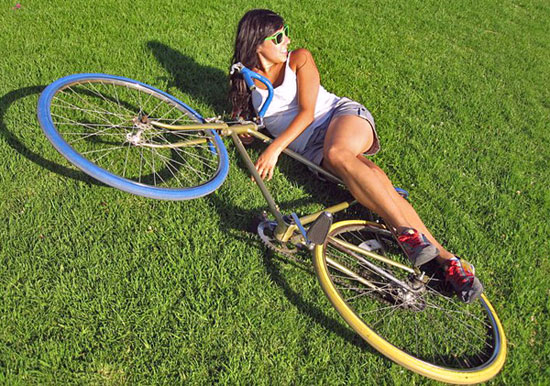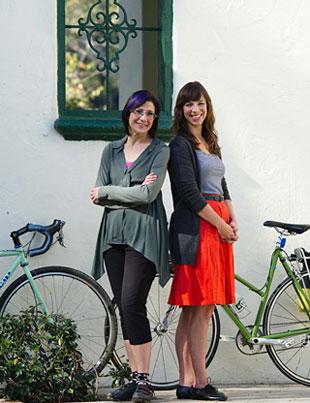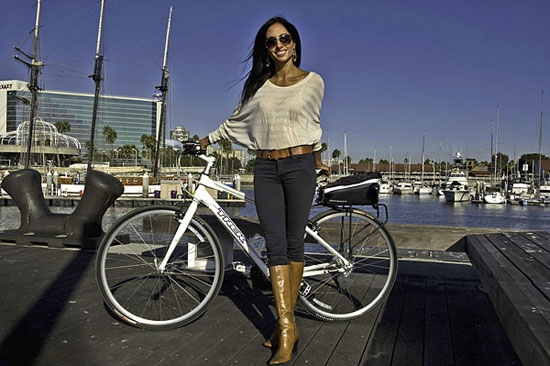Sisterhood of the traveling bikes
February 7, 2012

The movement to increase the number of women cyclists on L.A. streets includes Andrea Denike Martinez.
Andrea Denike Martinez still remembers the day she got back in the saddle.
It was Earth Day—April 22, 2010. For the first time since a bad bicycle accident fractured her skull and landed her in intensive care several years earlier, Martinez was ready to once again brave L.A.’s streets on two wheels.
Heading out from her Echo Park home, she was pumped up with environmental commitment—and “so nervous,” she recalled.
But moral support was also on the road that day. “I met another girl on a bike going that very same route.” She was a total stranger, but Katherine Gladwin was going in the same direction so they rode together to their jobs near Wilshire and Western.
They not only became fast friends, but started a small women’s cycling crew they dubbed the Bodacious Bike Babes. Since that first commute, they’ve organized and publicized group rides, volunteered at events like CicLAvia, and generally tried to encourage other women to take the plunge into an L.A. cycling world that remains overwhelmingly dominated by men.
Even though they may have felt alone out there at times, Martinez and Gladwin have plenty of company these days. On Wednesday, February 8, a coalition of women cycling advocates is set to gather in Long Beach to announce an ambitious goal: doubling the number of female bicyclists on Southern California streets within five years.
The initiative is led by a relatively new organization, Women on Bikes SoCal, which seeks to promote the “joy, beauty and benefits of bicycling for women.” Its campaign includes establishing the nation’s first women-only scholarship program for League Certified Bike Safety Instructors. (Information on supporting the initiative is here.)
One of the most visible faces of female cycling in Southern California, Long Beach Vice Mayor Suja Lowenthal, is among those backing the movement.
On a recent bicycle tour of her city, which is noted for its large and growing network of bike-friendly amenities, Lowenthal made it clear that dressing like Lance Armstrong—and riding like a Tour de France champion—are not required to join the cycling revolution.
“I want to wear my heels. I want to do all sorts of kinds of things that are about regular lifestyle,” Lowenthal said. “You don’t have to be the 50-mile-a-week spandex athlete. You can move about with your children and make it a very family-oriented, healthy, active lifestyle.”
In fact, Lowenthal thinks that the health and well-being of kids can be a powerful motivator in getting women to take up cycling. Childhood obesity is a “crisis of epic proportions,” she said, and there’s nothing like getting mothers on bikes to get everyone else onboard, too. “It is that green light: ‘Well, Mom’s OK with it,’ “ she said.
Still, if current statistics are any indication, there may be an uphill climb ahead.
The Los Angeles County Bicycle Coalition reports that only 16% of cyclists spotted during last year’s bicycle count were women—about the same percentage as in the previous count in 2009. A new report by the national advocacy group Alliance for Biking and Walking found that only 20% of those bicycling to work in Los Angeles are women—compared to 33% in Sacramento, 38% in Portland and a remarkable 49% in Memphis.

Jennifer Klausner, left, and Alexis Lantz of L.A. County Bicycle Coalition. Photo by Allan Crawford/Women on Bikes SoCal
Ask L.A. women cyclists, non-cyclists and would-be cyclists about the imbalance, and most are quick to sum up the problem in two words: too dangerous.
“A lot of it is people really are deathly afraid of cars, and the way people drive,” said Martinez, 33, co-founder of the Bodacious Bike Babes.
“It’s just too stressful being on the road,” added Kristen Schwarz, 28, who lives in East Hollywood and gave up her bicycle a couple of years ago after one too many encounters with speeding motorists. “It’s tough out there!”
Everyone, it seems, has a harrowing story or two.
“My first experiences in L.A. were pretty terrifying. I went down Wilshire. It was definitely a treacherous route,” said Gladwin, Martinez’s friend and co-founder. “My bicycling career in Los Angeles started in a pretty daunting fashion.”
She’s been struck twice by cars, the first time by a morning rush hour driver who mowed her down on Wilshire. “She stopped and she actually was complaining about heart palpitations because of the trauma she had experienced,” said Gladwin, 29, who was thrown to her knees in the collision. “I was intimidated but I wasn’t going to let that deter me.”
Magdalena Paluch, who interviewed women cyclists as part of a project to create a bicycling app while she earned her master’s degree in industrial design at Pasadena’s Art Center College of Design, said greater female involvement could lead to big things.
“I feel strongly that if anything will change, most of the time it changes because of the women. We are change agents,” she said. “Women are considered an ‘indicator species’ for biking and public transit because women are risk-averse. If you make it safe for women to bike, it’ll be safer for everybody.”
Cycling advocates agree. They say that creating more, and safer, facilities like “protected bike lanes”—in which riders are buffered from car traffic—and “bicycle boulevards” on slower-moving residential streets is the key to overcoming the perception and reality of dangerous L.A. streets.
Joe Linton, a CicLAvia consultant and longtime L.A. bicycle activist, noted that the gender disparity disappears in countries like the Netherlands, which has a highly developed network of bikeways and a culture in which cycling is considered a safe and commonplace way to get around.
“In very bicycle-safe cultures, women are actually the majority. In daredevil places, or places that are perceived as daredevil, like L.A., women are reluctant, and reluctant to go with kids,” Linton said. In Los Angeles, where men have long dominated the bike scene, it’s easy for experienced, hardcore cyclists to forget how women—and other less confident beginning riders—may view the challenges of the road, he said.
Advocates are increasingly pointing to women riders’ safety concerns as a way of advancing a broader agenda of making streets better for all cyclists and pedestrians, of all ages. “This is a growing issue,” said Alexis Lantz, planning and policy director for the Los Angeles County Bicycle Coalition.
In fact, the women’s safety argument has been made as part of a push for improvements in Los Angeles County’s Bicycle Master Plan, set to come before the Board of Supervisors in the weeks ahead.
Lantz said it also could be a factor as advocates press for more bicycle resources in the Southern California Association of Governments’ Regional Transportation Plan. And, on the federal level, she said, “Safe Routes to School” funding—which provides resources for many bicycle and pedestrian programs and is now threatened as part of the budget showdown in Washington—is another area in which women’s street safety concerns are a big part of the conversation.
Beyond the public policy arena, signs are everywhere that women are finally starting to make their move into the bike lane—at least a little bit.
Photos of bike-riding celebs like Zoe Deschanel, Hilary Duff and Vanessa Hudgens are all over the Internet, as are fashion-forward blogs such as Los Angeles Cycle Chic. Monday nights are reserved for women at the Bicycle Kitchen. Although nobody’s done a formal count, popular street-closing CicLAvia events seem to be bringing out large numbers of women. And young female activists are creating crews like Iron Unicorns, dedicated to creating “equality for women cyclists, both on the streets and in society.”
All those are valuable in building the women’s cycling movement, Lantz said.
“I think there is something that everyone can bring,” she said. “Cycle chic is a really great way of promoting cycling for some women. I really think that the more attention brought to cycling, the better.”
Posted 2/7/12













 405 bridge work causes a stink
405 bridge work causes a stink

